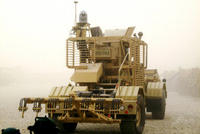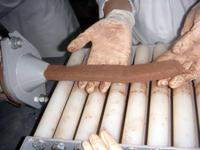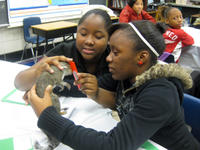-
Potentially devastating asteroid collision in 2040 not likely to happen
A team of astronomers from the University of Hawaii’s Institute for Astronomy (IfA) have confirmed that the chance of asteroid 2011 AG5 impacting Earth in 2040 is no longer a significant risk — prompting a collective sigh-of-relief; previously, scientists estimated that the risk of this 140-meter-diameter (about the length of two American football fields) asteroid colliding with the Earth – and releasing about 100 megatons of energy — was as high as one in 500
-
-
Regulating geo-engineering schemes
With policymakers and political leaders increasingly unable to combat global climate change, more scientists are considering the use of manual manipulation of the environment to slow warming’s damage to the planet; some legal scholars argue that the legal ramifications of this kind of geo-engineering need to be thought through in advance and a global governance structure put in place soon to oversee these efforts
-
-
Ninth-grader wins award for solar-powered water purification system
Ninth-grader Deepika Kurup of Nashua High School in New Hampshire won $25,000 and named America’s Top Young Scientist for her innovative new water-purification system; her prototype, which harnesses solar energy to disinfect contaminated water, can help improve the lives of the 1.1 billion people around the world who lack access to clean drinking water
-
-
UV offers hope for safer drinking water
Recent changes in the Environmental Protection Agency’s (EPA) surface water treatment rules mandate, among other things, more aggressive monitoring and control of various pathogens, notably including Cryptosporidium; this microbe, which can cause severe illness or death, is highly resistant to chlorine-based disinfection practices; as one means to reducing the threat, the EPA has called for treating water with ultraviolet (UV) radiation, which also serves as a “secondary barrier” to inactivate (prevent reproduction of) other key pathogens such as adenovirus and other viruses, as well as bacteria and parasites such as Giardia
-
-
Laws of traditional physics would foil Santa's effort to carry out mission
Santa has 31 hours to visit 378 million Christian children; at the rate of 3.5 children per household, and assuming at least one good child per home, this comes to 108 million homes; if each child receives no more than a medium sized Lego set (two pounds), the sleigh would be carrying more than 500 thousand tons, not counting Santa himself; Santa would thus need at least 360,000 Reindeer to pull the sleigh; since Santa must visit 108 million homes in 31 hours, he will have to travel at 650 miles per second — 3,000 times the speed of sound; at that speed, the lead pair of Reindeer would absorb 14.3 quintillion joules of energy per second each and vaporize — indeed, the entire Reindeer team would be vaporized within 4.26 thousandths of a second; Santa himself would be subjected to forces of 17,500 Gs; a 250 pound Santa (which seems ludicrously slim) would be pinned to the back of the sleigh by 4,315,015 pounds of force, and be crushed
-
-
Army engineers develop new roadway threat detection system

Explosives along roadways remain an unrelenting hazard for deployed soldiers; U.S. Army engineers have developed a system for detecting possible threats by identifying potential threat locations on unimproved roads; the system can perform region of interest cueing of threats at greater standoff distances, which can be further interrogated by the radar as the vehicle gets closer to the threat
-
-
Maintaining robust communications in congested and contested environments
Radios are used for a wide range of tasks, from the most mundane to the most critical of communications, from garage door openers to military operations’ as the use of wireless technology proliferates, radios and communication devices often compete with, interfere with, and disrupt the operations of other devices; a new DARPA challenge is looking for innovative approaches that ensure robust communications in such congested and contested environments
-
-
What we know, and what we can do, about school shootings
Since the early 1970s, school shootings at American elementary, secondary, and higher education institutions have been a painful reality for American society; after each incident — like the recent attack in Newtown, Connecticut — there is voluminous dialogue about what can be done to prevent the next such tragedy; a new study explores what we have learned about these tragic incidents, and what can be done to prevent them
-
-
Bricks made from paper waste

Spanish researchers have mixed waste from the paper industry with ceramic material used in the construction industry; the result is a brick that has low thermal conductivity meaning it acts as a good insulator; its mechanical resistance, however, still requires improvement
-
-
Some geo-engineering approaches to combat climate change may not work
Numerous geo-engineering schemes have been suggested as possible ways to reduce levels of the greenhouse gas carbon dioxide in the atmosphere and so reduce the risk of global warming and climate change; one such technology involves dispersing large quantities of iron salts in the oceans to fertilize otherwise barren parts of the sea and trigger the growth of algal blooms and other photosynthesizing marine life; seeding the oceans with iron, however, may not address carbon emissions
-
-
Sandy relief bill says rebuilding effort should take into consideration climate-related risks
The $60 billion Sandy relief bill being debated this week in the Senate does not specifically mention the words climate change or global warming, but it implicitly raises topics and themes which are part of the climate change discussion; the bill says that federal, state, and local agencies engaged in the post-Sandy rebuilding effort should take into consideration “future extreme weather events, sea level rise and coastal flooding”
-
-
Innovative Atmospheric Vortex Engine for energy generation
A Canadian company offers a new energy generation concept: the Atmospheric Vortex Engine (AVE) uses low-temperature waste heat to create a tornado-like atmospheric vortex; in contrast with a real tornado, the vortex cannot go anywhere because it is anchored to its heat source. So it is really more like a dust devil or waterspout, and it serves as a low-cost virtual chimney
-
-
Fuels, household chemicals made from sugar
Scientists at the University of Manchester have identified a biocatalyst which could produce chemicals found in ice-cream and household items such as soap and shampoo — possibly leading to the long-term replacement of chemicals derived from fossil fuels
-
-
Encouraging science research, study among minorities

A study published last year, in which 83,000 grant applications from 2000 through 2006 were examined, found that African American scientists were far less likely therethan white scientists to obtain research money from the National Institute of Health (NIH); NIH is setting up a program to change that
-
-
Connection between goth subculture, mass shootings appears tenuous

Classmates of the otherwise bland and elusive Adam Lanza, who last Friday killed twenty children and six adults at the Sandy Hook school in Newton, Connecticut, described him as “goth”; is there a “goth” connection in the Newtown school shooting? The question is asked because news reports have connected several perpetrators of both mass shooting and killing on a smaller scale to goth culture; a closer examination shows that the relationship between goth and mass shooting is tenuous
-
More headlines
The long view
A Shining Star in a Contentious Legacy: Could Marty Makary Be the Saving Grace of a Divisive Presidency?
While much of the Trump administration has sparked controversy, the FDA’s consumer-first reforms may be remembered as its brightest legacy. From AI-driven drug reviews to bans on artificial dyes, the FDA’s agenda resonates with the public in ways few Trump-era policies have.
Risk Assessment with Machine Learning
Researchers utilize geological survey data and machine learning algorithms for accurately predicting liquefaction risk in earthquake-prone areas.
Foundation for U.S. Breakthroughs Feels Shakier to Researchers
With each dollar of its grants, the National Institutes of Health —the world’s largest funder of biomedical research —generates, on average, $2.56 worth of economic activity across all 50 states. NIH grants also support more than 400,000 U.S. jobs, and have been a central force in establishing the country’s dominance in medical research. Waves of funding cuts and grant terminations under the second Trump administration are a threat to the U.S. status as driver of scientific progress, and to the nation’s economy.
The True Cost of Abandoning Science
“We now face a choice: to remain at the vanguard of scientific inquiry through sound investment, or to cede our leadership and watch others answer the big questions that have confounded humanity for millennia —and reap the rewards.”
Bookshelf: Smartphones Shape War in Hyperconnected World
The smartphone is helping to shape the conduct and representation of contemporary war. A new book argues that as an operative device, the smartphone is now “being used as a central weapon of war.”
New Approach Detects Adversarial Attacks in Multimodal AI Systems
New vulnerabilities have emerged with the rapid advancement and adoption of multimodal foundational AI models, significantly expanding the potential for cybersecurity attacks. Topological signatures key to revealing attacks, identifying origins of threats.
